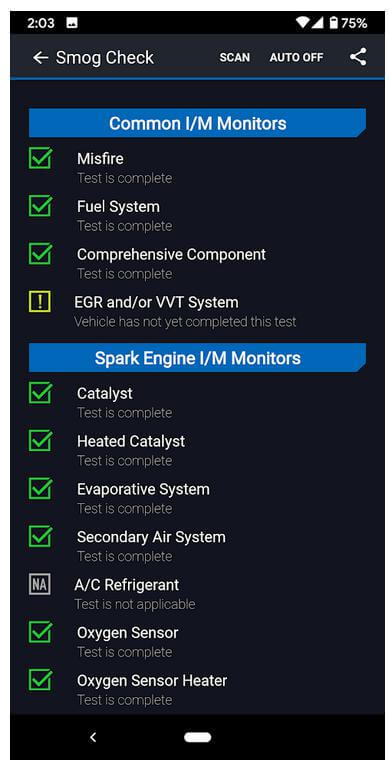How to check if trouble codes have been cleared?
If you’re buying a used car, check if trouble codes have been cleared recently
Clearing trouble codes is a great way to fool an unsuspecting car buyer into thinking that the car or truck is in good condition because the check engine light will be out. If you’re buying a used car it’s critical to check if trouble codes have been cleared recently. Here’s how to do that.
What you need to check if codes have been cleared
A scan tool or code reader capable of showing the status of the readiness monitors.
What is a readiness monitor?
Car computers run tests on individual

Here’s an example of a Blue Driver scan tool software report on readiness monitors. Notice that the EGR and/or VVT system has a problem and has not completed its readiness test.
engine and emissions systems. These tests are referred to as readiness monitors. Some of the monitors run once and if the system passes, the system is marked as ready and not checked again for a certain period of time.
Other systems are constantly monitored and if they fail, they will set a check engine light.
As soon as a dishonest seller clears current trouble codes from the computer, the readiness monitors reset and must go through all their “drive cycles” to complete the tests.
Drive cycle tests can take a single short trip or as long as a hundred miles to complete. During that period of time while the tests are running, the cheek engine light will be off and THAT’s where you’re most at risk for buying a problem vehicle.
How to check if trouble codes have been cleared
Plug your scan tool into the OBDII port and search for readiness monitors or I/M (Inspection/Maintenance) monitors. If any monitors are not ready or have an ! or X, there’s a problem with that system. Either it hasn’t completed testing or it can’t test because another system is faulty and preventing it from completing its testing. Either way, it’s a huge red flag if you’re considering buying that vehicle.
Next, check for History Codes. These are codes that have been set in the past but are not not current.
Then, check for PENDING CODES. The ECU tracks data that’s out of spec but doesn’t set a trouble code until the data reaches a certain threshold. For example, the ECU may track misfires on a certain cylinder but not set a misfire code for that cylinder until it detects 200 or more misfires. If the misfire count is below 200, those misfires may be stored as a pending code.
Check Mode $06
Mode$06 is literally a peek behind the curtain of the user friendly graphical interface. It shows you raw data. Using our cylinder misfire example above, Mode $06 will tell you exactly how many misfires each cylinder has accumulated.
©, 2022 Rick Muscoplat
Posted on by Rick Muscoplat